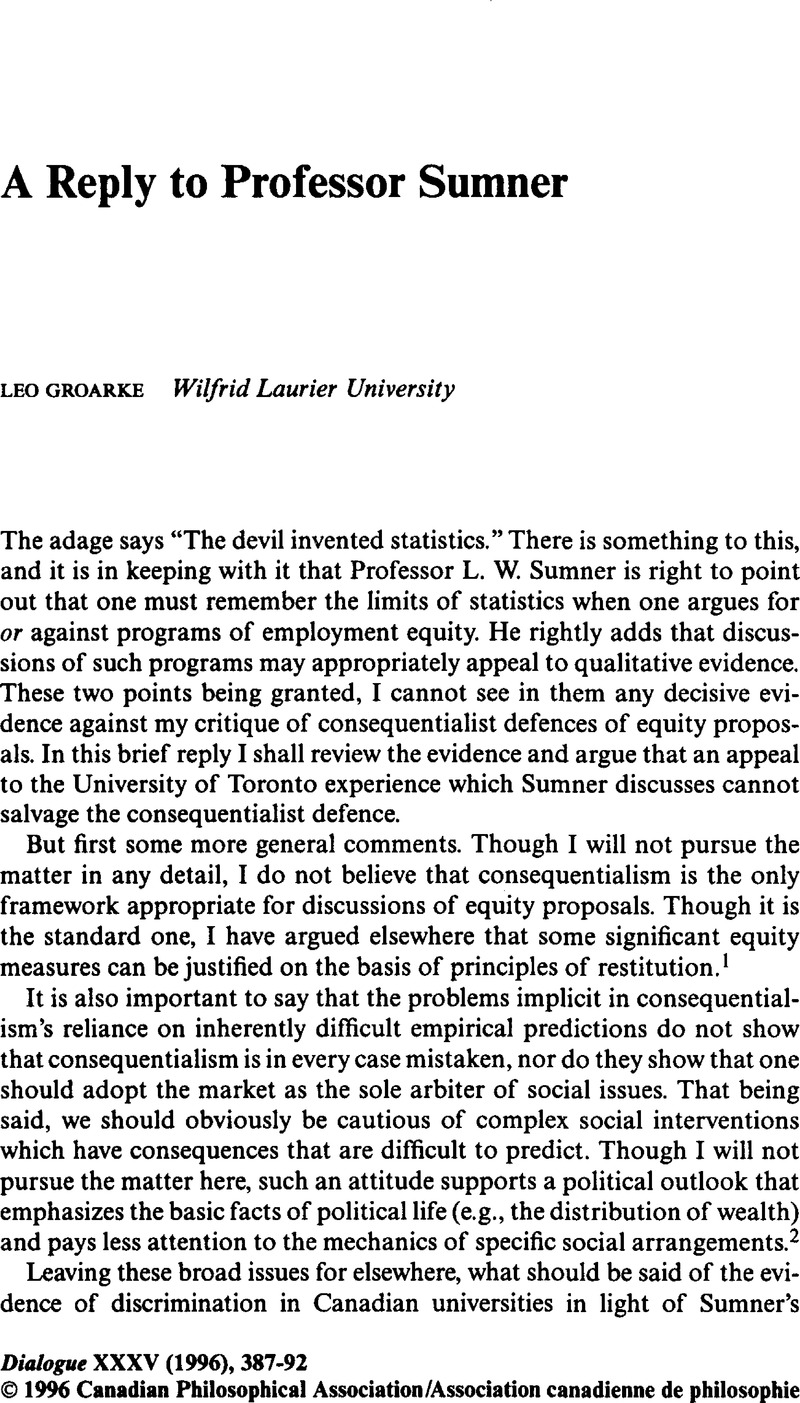No CrossRef data available.
Published online by Cambridge University Press: 13 April 2010

1 See my “Affirmative Action as a Form of Restitution,” in Business Ethics: A Philosophical Reader, edited by Thomas I., White (New York: Macmillan, 1993), pp. 640–47.Google ScholarThe article first appeared in the Journal of Business Ethics, 9 (1990): 207–13.CrossRefGoogle Scholar
2 Such an emphasis raises difficult questions for equity policies because they have granted advantages primarily to the privileged members of “designated” groups. For the statistical evidence, see Sowell, Thomas, Preferential Policies: An International Perspective (New York: W. Morrow, 1990).Google Scholar The kind of critique of feminism this makes possible can be seen in Kline, Marlee, “Women's Oppression and Racism: A Critique of the ‘Feminist Standpoint’,” in Race, Class, Gender: Bonds and Barriers, edited by Vorst, Jessie (Toronto: Between the Lines, 1989).Google Scholar
3 One classic paper that underscores this problem is Hastorf and Cantril's study of the perceptions of an infamous football game between Princeton and Dartmouth. Showing the same tapes of the game to different partisan groups produced remarkably different perceptions of what happened. Alumni and students consistently “saw” the game in a way that exonerated players from their own school. See Albert, H. Hastorf and Cantril, Hadley, “They Saw a Game,” in Rhetoric: Discovery and Change, edited by Richard, E. YoungAlton, L. Becker and Kenneth, L. Pike (New York: Harcourt, Brace – World, 1970), pp. 31–39.Google Scholar
4 See Dagg, Anne Innis, “Tenure and Promotion,” in Hiring and Retention of Women Faculty, edited by OCUFA Status of Women Committee (Toronto: Ontario Confederation of University Faculty Associations, 1992), p. 7.Google Scholar
5 Sumner mentions the PBS documentary Discovering Women. For some Canadian examples of ill-founded charges of discrimination, one might consult the CTV program Harassment Police, originally broadcast on W5 on October 4, 1994. One might also cite the U.B.C. report by Joan McEwen, which resulted in the suspension of the graduate political science program, a suspension which the administration was forced to end in view of the flaws in her report. See below.
6 The sloppiness that characterizes many general charges of systemic discrimination is discussed in Martin, Robert, “Guesswork,” The Literary Review of Canada, 4, 2 (February 1995).Google Scholar He discusses four reports on related matters. Methodological problems also characterize more careful studies. Consider, for example, Mura's, R. survey of Canadian mathematics departments (“Sans distinction de sexe? Les carrieres universitaires en science mathematiques,” Canadian Journal of Higher Education, 21, 3 [1991]: 72–96).Google Scholar She reports that 41.8% of the women she interviewed thought “or suspected” they had been victims of discrimination. It is hard to know what to do with such suspicions, especially as Mura defines discrimination in a very broad way, does not attempt to determine how frequently such incidents occur and does not distinguish problems from many years ago and those of more recent vintage. The men included in her survey disproportionately represent higher academic ranks, though it is junior male faculty who are most likely to believe they are victims of discrimination.
All this being said, very few of the women Mura surveyed described instances of discrimination in employment and it is clear that complaints about promotion figure prominently in her results. These complaints deserve statistical attention though it must also be remembered that personal impressions of this particular sort are highly unreliable (one might seriously wonder whether anyone denied promotion has ever believed that this was justified).
7 Good, Graham, “Facecrimes,” Literary Review of Canada, 4, 10 (October 1995), p. 17.Google Scholar
8 In one case in which I was personally involved, a graduate student who proposed to use the chilly climate methodology to investigate the views of male Ph.D. students re: discrimination against men was so poorly received by the ethics committee that the student decided it was advisable to drop the project.
9 A similar pattern is studied in Boyce, J. W., “Manufacturing Concern: Worthy and Unworthy Victims: Headline Coverage of Male and Female Victims of Violence” (M.A. Thesis, Wilfrid Laurier University, 1994).Google Scholar Using qualitative and quantitative methods, he studies headline and newspaper coverage of male and female victims of violence in Canadian daily newspapers in the years 1989 to 1992. Though he concludes that police statistics, surveys and statistical research all suggest that men and women are victims of violence to roughly equal extents, he finds that women are emphasized in newspaper coverage 35 to 51 times more than men. He describes the way in which qualitative evidence can be abused: “In exploring the violence facing women [this coverage] rarely quantifies women's victimization in relationship to that of men but, instead, personalizes it and provides readers with concrete, individual examples which allow the reader to identify with the victims. Even though headlines emphasizing men report that they face a level of violence as high as that of women, there are few qualitative headlines that place their suffering into a societal context or personalize it. On the contrary, men are more likely to be identified inqualitative headlines as perpetrators of violence, serving to reinforce the focus on women's suffering” (Ibid., pp. 54–55).
10 If, in my own department, we decided to forego the hiring of an individual in a particular area of philosophy, that would probably mean that this area would not be covered in our program.
11 The statistics suggest that women were favoured in hiring even before equity programs were instituted, and most departments that have hired have frequently hired women without policies like those at the University of Toronto.
12 These problems, and potential ways of minimizing them, have been apparent for some time. See, for example, my “Beyond Affirmative Action,” Atlantis: A Women's Studies Journal, 9, 1 (1983): 13–24.Google Scholar
13 I would like to thank my brother, Louis Groarke, for comments on a draft of this reply.